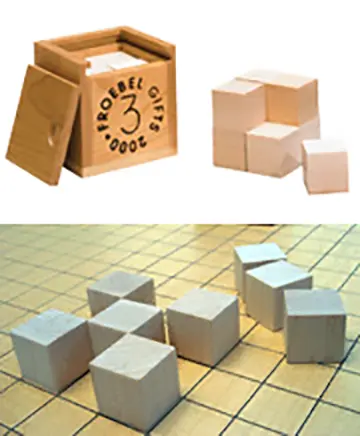Gift Three: The Divided Cube
Froebel’s Gift 3 divides the two-inch cube from the previous Gift into eight 1″ cubes.
PRESENTATION
The presentation of the blocks is done in an orderly fashion to maintain the initial wholeness of the cube. The box is turned
upside down, lid on the bottom. The box is carefully lifted off, revealing the two-inch cube from Gift 2 now made from eight
one-inch cubes. This is the process for opening Gifts 3 through 6. Gently insist on this ritual — no dumping of the blocks. The
child will develop a respect for this order if you show them that you also respect it. It is also important to use all of the
pieces when working with the Gift since the wholeness is a key point. The child will begin to see the pieces as part of the whole
cube and their relationship to the whole. In this way, nothing is wasted or left out. This is a subtle but powerful message of
inclusion and conservation. Putting the Gift away is the reverse of the presentation. Have the child reassemble the whole cube on
the lid, cover with the base, and then flip the box upright. Actually, this process is really just a continuation of the presentation
and of the whole cycle of playing with each Gift. The underlying concept is of a unity of parts moving through various forms and
returning to the whole (before the whole cycle repeats again). This idea is planted in a child’s mind like a seed and will germinate
until the child begins to see this cycle in broader life, as well. Froebel strongly believed in the value of symbolic play. “What
shape is this?” Have the child count the number of cubes. Count the six faces of each cube, the twelve edges and the eight corners.
Emphasize this idea by returning to this observation with individual children at different times during play.

FORMS OF LIFE
Have the child use the blocks to represent things from his/her life. The child may begin with simple forms (trains, towers, etc.) and
make associations and create stories. Encourage these associations and stories by asking questions. Children tend to do this naturally
during block play. Far from simple use of imagination, these associations between their inner and outer worlds are the foundation of real
learning.
FORMS OF KNOWLEDGE
Sorting, differentiation, counting, arithmetic (addition, subtraction, multiplication, division), fractions (parts of whole), and
concepts/vocabulary (line, cube, square, plus, equal, half, etc.) can be reasoned with this Gift. Let each child build his/her own
construction, then talk about the number of cubes that have been used in different ways. The child will begin to make associations
with concrete three-dimensional work, as opposed to purely abstract mathematical thinking. Return to counting the number of cubes,
sides, edges and corners. Begin by counting the cubes and placing them next to each other in a line and stating “one and one is two,”
“two and one is three,” etc. The child will discover proportions and see operations of addition/subtraction through “half of eight is
four” or “two from three is one,” etc. The blocks can be stacked or combined into layers to illustrate multiplication, division and
fractions (“four times two equals eight”).
FORMS OF BEAUTY
Forms of Beauty can be created on a gridded board or free form on a table. Forms of Beauty start with the cube and progress one
cube at a time — changing and evolving a design, then returning to the cube once again. Encourage the child to continually modify a
construction of the cubes rather than tearing down and rebuilding. One thing should lead to the next. Froebel believed that this
would leave ideas in a child’s mind. This process promotes the logical and orderly development of ideas. Be sure to follow the child’s
invention and not “tell” him/her what to do with the cubes. Listen to the stories. Use the blocks to awaken a sense of beauty by forming
symmetrical designs. These designs embody the principles of symmetry, proportion, balance, strength of center, rhythm and simplicity.
